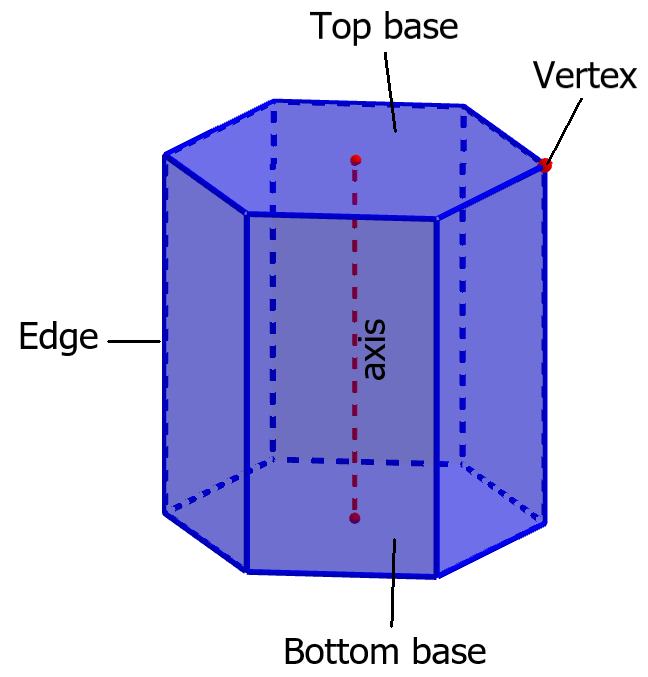A hexagonal prism is a polyhedron that has two hexagonal faces that are parallel to each other. The hexagonal faces are called bases. These two faces are joined by six lateral rectangular faces. If the prism is regular, both bases are equal and the lateral faces are also equal. In total, these prisms have 8 faces. In addition, edges and vertices are other important elements of prisms. Hexagonal prisms have 12 vertices and 18 edges.
Here, we will learn about other important elements of hexagonal prisms. We will use diagrams to illustrate the concepts.
Elements of a hexagonal prism
The elements of a rectangular prism are:
- Bases
- Height
- Axis
- Edges
- Lateral area
- Cross section
- Vertices

Bases
Any prism has two bases that are congruent and parallel. In the case of hexagonal prisms, the bases are two hexagons. Usually, we denote these areas using $latex A_{b}$.
Height
Height is defined as the perpendicular distance between the two bases of the prism. We use h to denote the height.
Axis
The axis is a line segment that connects the centroid of both bases. The length of the axis is equivalent to the length of a lateral edge.
Edges
Edges are line segments that connect two vertices. We can also call the edges as the segments where two faces of the prism intersect. A hexagonal prism has a total of 18 edges.
Lateral area
The lateral area corresponds to the area of the lateral faces of the prism. In the case of hexagonal prisms, the lateral faces are rectangles. If the prism is regular, all six side faces have the same area.
Cross section
A cross-section is a section formed by cutting the prism with a plane that is perpendicular to the axis of the prism. The cross-section of a hexagonal prism is shaped like a hexagon.
Vertices
Vertices are the points formed by the intersection of two or more edges. In this case, the vertices of hexagonal prisms are formed by the intersection of three edges. These prisms have a total of 6 vertices.
Important formulas of a hexagonal prism
Hexagonal prisms are 3D figures, so their most used formulas are the volume formula and the surface area formula.
Formula for the volume
We can calculate the volume of a hexagonal prism by multiplying the area of its base by its height. Therefore, we have:
| $latex V=\frac{3\sqrt{3}}{2}{{a}^2}h$ |
where a is the length of the sides of the base and h is the length of the height of the prism.
Formula for the surface area
The surface area is found by adding the areas of the faces of the prism. We have two hexagonal faces and six rectangular faces, so we have:
| $latex A_{s}=3\sqrt{3}{{a}^2}+6ah$ |
Examples of problems with hexagonal prisms
EXAMPLE 1
What is the volume of a prism that has a height of 6 m and a hexagonal base with sides of length 3 m?
Solution: We use the volume formula with the given information:
$latex V=\frac{3\sqrt{3}}{2}{{a}^2}h$
$latex V=\frac{3\sqrt{3}}{2}{{(3)}^2}(6)$
$latex V=140.3$
The volume of the prism is 140.3 m³.
EXAMPLE 2
What is the surface area of a prism that has a hexagonal base with sides of 5 m and a height of 8 m?
Solution: We use the formula for surface area with the given information:
$latex A_{s}=3\sqrt{3}{{a}^2}+6ah$
$latex A_{s}=3\sqrt{3}{{(5)}^2}+6(5)(8)$
$latex A_{s}=129.9+240$
$latex A_{s}=369.9$
The surface area of the prism is 369.9 m².
See also
Interested in learning more about hexagonal prisms? Take a look at these pages:



